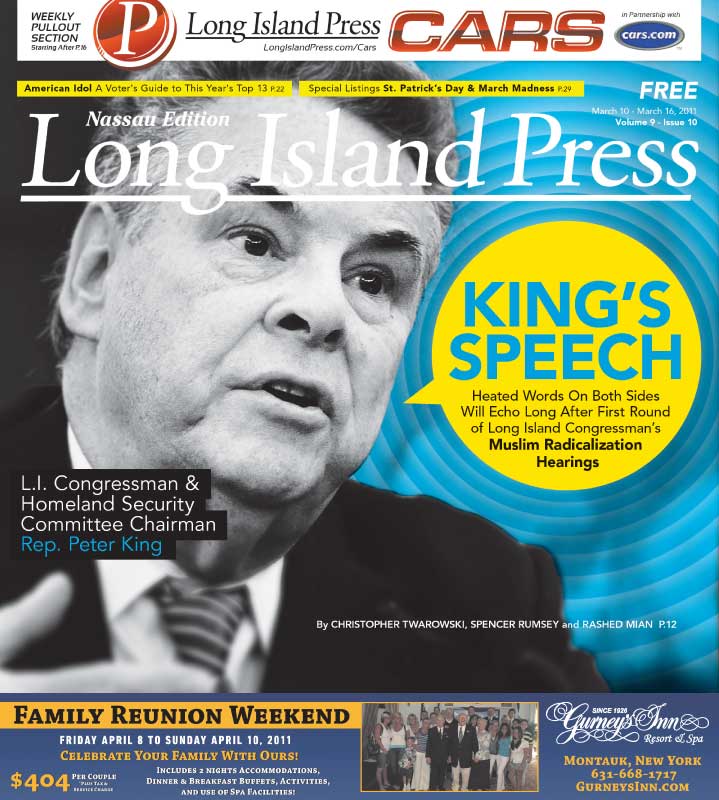

Pat Bowden, President of Transport Workers Union Local 252, joins her members helping participants attend last summer’s Special Olympics in Nassau.
How Did We Get Here?
Last fall transit advocates hoped that the county executive could compromise with the MTA and find a way to raise its subsidy of the bus service. Nassau Comptroller George Maragos had issued an audit in November, saying that if the MTA improved “its efficiencies” it could increase its operating subsidy several million dollars and thereby help the county step up with more of its share. It didn’t work out that way. Still, hope springs eternal, apparently. The belief that the MTA could somehow still come in and make everything all right−especially if Gov. Andrew Cuomo could find a replacement for the outgoing MTA Chairman Jay Walder who might be more compatible with Mangano−was the underlying theme at a recent rally held on the steps of the Nassau Legislative Building in Mineola on Oct. 3. But sources in the MTA told the Long Island Press that “that bus has left the station.”
As has been well reported, the MTA has been facing a $32 billion deficit (it was $28 billion in 2010), with its capital program in dire need and the state strapped for cash. It’d been knocking on Nassau County’s door for years, sources said, getting more persistent with former County Executive Tom Suozzi, whom Mangano managed to beat in a squeaker election in 2009. This year the MTA’s patience finally ran out.
MTA board member Mitchell Pally, an attorney who’s now the chief executive officer of the Long Island Builders Institute, said that Nassau has been “stiffing” the MTA for some 30 years. He was well aware of the negotiations going on between Ed Mangano and Walder, who will be leaving the MTA soon to run an expanding mass transit system in Hong Kong.
“We didn’t even ask them for the money back,” Pally says. “All we said is that starting in 2012, we would request that you pay what the contract says you’re supposed to pay.”
According to Pally, the county’s subsidy was supposed to be $26 million; the county was only paying $9 million—and it hopes to pay less than $3 million next year. Pally said the MTA was willing to let the county “phase in over a three-year period” to get to the $26 million. “You don’t have to raise taxes,” Pally said, noting Suffolk’s $25 million subsidy of its system, Westchester’s $30 million. “It’s all a matter of priorities. How important is the bus system to the people making that decision?”
“The MTA demanded $26 million more that we don’t have,” says Schmitt, who lambasted the MTA. “We said no, and [then] they were going to cut 53 percent of the routes. And when we said no, they gave notice they were going to terminate the contract to run our buses and they were leaving as of January 1st. So the choices that faced us were either to shut down or to privatize…. The MTA put their payroll tax on [us] and they’re taking $100 million out of Nassau County. And then they turn around and hold a gun to our head and say, ‘Give us $26 million more to run your buses and we’re going to cut your routes by 53 percent.’ Well, you know what, go scratch!”
“Nassau County was getting a great deal,” counters TWU spokesman Jamie Horowitz. “They weren’t paying anywhere near what surrounding counties were paying for the same level of service from the MTA. From our vantage point, it looked like a lot of this was very personal between Walder and Mangano.”
Not so, says Pally. A personality clash “had nothing to do with it.” He said the county “had a position and they stuck to it. At that point the MTA decided it was not fair to the other counties to subsidize Nassau beyond what everybody else was being subsidized. And so we told them if they wanted to, they could run the system themselves. They decided to do so.”
Some Nassau Republicans see it differently.
“It was the MTA that pulled out,” says state Sen. Charles Fuschillo, Jr. (R-Merrick), chairman of the Senate transportation committee, who said that its action “caused Nassau County to look for alternatives.”
He’s confident that the state will continue its subsidy, which was some $54 million last year, and he held out high hopes for the agreement between Nassau and Veolia.
“I’m hopeful Nassau County and the contractor can continue the service that has been provided and that there’s a continuity of the routes and that the employees maintain their jobs,” Fuschillo says.
“Critics say, ‘What about after one year?’” says Schmitt. “Well, after one year we’ll deal with it. Right now, you would have Armageddon in the bus world on Jan. 1. 2012. This pushes it off to Jan. 1, 2013. Who the hell knows what’s going to happen [between now and then]? This literally keeps the buses driving.”
And that may be as good as it gets for now. But will it be enough for those who actually use the transit system like Robert Cole, Francisco Cabrera and Peggy Moise?





